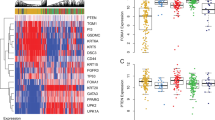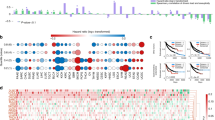Abstract
Alterations in DNA repair pathways are common in tumors and can result in characteristic mutational signatures; however, a specific mutational signature associated with somatic alterations in the nucleotide- excision repair (NER) pathway has not yet been identified. Here we examine the mutational processes operating in urothelial cancer, a tumor type in which the core NER gene ERCC2 is significantly mutated. Analysis of three independent urothelial tumor cohorts demonstrates a strong association between somatic ERCC2 mutations and the activity of a mutational signature characterized by a broad spectrum of base changes. In addition, we note an association between the activity of this signature and smoking that is independent of ERCC2 mutation status, providing genomic evidence of tobacco-related mutagenesis in urothelial cancer. Together, these analyses identify an NER-related mutational signature and highlight the related roles of DNA damage and subsequent DNA repair in shaping tumor mutational landscape.
This is a preview of subscription content, access via your institution
Access options
Subscribe to this journal
Receive 12 print issues and online access
$209.00 per year
only $17.42 per issue
Buy this article
- Purchase on Springer Link
- Instant access to full article PDF
Prices may be subject to local taxes which are calculated during checkout






Similar content being viewed by others
Accession codes
References
Cancer Genome Atlas Research Network. Integrated genomic analyses of ovarian carcinoma. Nature 474, 609–615 (2011).
Dietlein, F., Thelen, L. & Reinhardt, H.C. Cancer-specific defects in DNA repair pathways as targets for personalized therapeutic approaches. Trends Genet. 30, 326–339 (2014).
Garraway, L.A. & Lander, E.S. Lessons from the cancer genome. Cell 153, 17–37 (2013).
Alexandrov, L.B. et al. Signatures of mutational processes in human cancer. Nature 500, 415–421 (2013).
Kasar, S. et al. Whole-genome sequencing reveals activation-induced cytidine deaminase signatures during indolent chronic lymphocytic leukaemia evolution. Nat. Commun. 6, 8866 (2015).
Helleday, T., Eshtad, S. & Nik-Zainal, S. Mechanisms underlying mutational signatures in human cancers. Nat. Rev. Genet. 15, 585–598 (2014).
Marteijn, J.A., Lans, H., Vermeulen, W. & Hoeijmakers, J.H. Understanding nucleotide excision repair and its roles in cancer and ageing. Nat. Rev. Mol. Cell Biol. 15, 465–481 (2014).
Lawrence, M.S. et al. Mutational heterogeneity in cancer and the search for new cancer-associated genes. Nature 499, 214–218 (2013).
Fuss, J.O. & Tainer, J.A. XPB and XPD helicases in TFIIH orchestrate DNA duplex opening and damage verification to coordinate repair with transcription and cell cycle via CAK kinase. DNA Repair (Amst.) 10, 697–713 (2011).
Compe, E. & Egly, J.M. TFIIH: when transcription met DNA repair. Nat. Rev. Mol. Cell Biol. 13, 343–354 (2012).
Cancer Genome Atlas Research Network. Comprehensive molecular characterization of urothelial bladder carcinoma. Nature 507, 315–322 (2014).
Van Allen, E.M. et al. Somatic ERCC2 mutations correlate with cisplatin sensitivity in muscle-invasive urothelial carcinoma. Cancer Discov. 4, 1140–1153 (2014).
Guo, G. et al. Whole-genome and whole-exome sequencing of bladder cancer identifies frequent alterations in genes involved in sister chromatid cohesion and segregation. Nat. Genet. 45, 1459–1463 (2013).
Yap, K.L. et al. Whole-exome sequencing of muscle-invasive bladder cancer identifies recurrent mutations of UNC5C and prognostic importance of DNA repair gene mutations on survival. Clin. Cancer Res. 20, 6605–6617 (2014).
Freedman, N.D., Silverman, D.T., Hollenbeck, A.R., Schatzkin, A. & Abnet, C.C. Association between smoking and risk of bladder cancer among men and women. J. Am. Med. Assoc. 306, 737–745 (2011).
Ploeg, M., Aben, K.K. & Kiemeney, L.A. The present and future burden of urinary bladder cancer in the world. World J. Urol. 27, 289–293 (2009).
Benhamou, S. et al. DNA adducts in normal bladder tissue and bladder cancer risk. Mutagenesis 18, 445–448 (2003).
Lee, H.W. et al. Acrolein- and 4-aminobiphenyl-DNA adducts in human bladder mucosa and tumor tissue and their mutagenicity in human urothelial cells. Oncotarget 5, 3526–3540 (2014).
Talaska, G., al-Juburi, A.Z. & Kadlubar, F.F. Smoking related carcinogen–DNA adducts in biopsy samples of human urinary bladder: identification of N-(deoxyguanosin-8-yl)-4-aminobiphenyl as a major adduct. Proc. Natl. Acad. Sci. USA 88, 5350–5354 (1991).
Gao, W. et al. Genetic polymorphisms in the DNA repair genes XPD and XRCC1, p53 gene mutations and bladder cancer risk. Oncol. Rep. 24, 257–262 (2010).
Stern, M.C. et al. Polymorphisms in DNA repair genes, smoking, and bladder cancer risk: findings from the International Consortium of Bladder Cancer. Cancer Res. 69, 6857–6864 (2009).
Tan, V.Y. & Févotte, C. Automatic relevance determination in nonnegative matrix factorization with the β-divergence. IEEE Trans. Pattern Anal. Mach. Intell. 35, 1592–1605 (2013).
Nik-Zainal, S. et al. Association of a germline copy number polymorphism of APOBEC3A and APOBEC3B with burden of putative APOBEC-dependent mutations in breast cancer. Nat. Genet. 46, 487–491 (2014).
Roberts, S.A. et al. An APOBEC cytidine deaminase mutagenesis pattern is widespread in human cancers. Nat. Genet. 45, 970–976 (2013).
Poon, S.L. et al. Genome-wide mutational signatures of aristolochic acid and its application as a screening tool. Sci. Transl. Med. 5, 197ra101 (2013).
Schmeiser, H.H., Schoepe, K.B. & Wiessler, M. DNA adduct formation of aristolochic acid I and II in vitro and in vivo. Carcinogenesis 9, 297–303 (1988).
Hoang, M.L. et al. Mutational signature of aristolochic acid exposure as revealed by whole-exome sequencing. Sci. Transl. Med. 5, 197ra102 (2013).
Poon, S.L. et al. Mutation signatures implicate aristolochic acid in bladder cancer development. Genome Med. 7, 38 (2015).
Kamburov, A. et al. Comprehensive assessment of cancer missense mutation clustering in protein structures. Proc. Natl. Acad. Sci. USA 112, E5486–E5495 (2015).
Kumar, P., Henikoff, S. & Ng, P.C. Predicting the effects of coding non-synonymous variants on protein function using the SIFT algorithm. Nat. Protoc. 4, 1073–1081 (2009).
Pfeifer, G.P. et al. Tobacco smoke carcinogens, DNA damage and p53 mutations in smoking-associated cancers. Oncogene 21, 7435–7451 (2002).
Francioli, L.C. et al. Genome-wide patterns and properties of de novo mutations in humans. Nat. Genet. 47, 822–826 (2015).
Green, P. et al. Transcription-associated mutational asymmetry in mammalian evolution. Nat. Genet. 33, 514–517 (2003).
Haradhvala, N.J. et al. Mutational strand asymmetries in cancer genomes reveal mechanisms of DNA damage and repair. Cell 164, 538–549 (2016).
Polak, P. & Arndt, P.F. Transcription induces strand-specific mutations at the 5′ end of human genes. Genome Res. 18, 1216–1223 (2008).
Alexandrov, L.B. et al. Clock-like mutational processes in human somatic cells. Nat. Genet. 47, 1402–1407 (2015).
Groenendijk, F.H. et al. ERBB2 mutations characterize a subgroup of muscle-invasive bladder cancers with excellent response to neoadjuvant chemotherapy. Eur. Urol. 69, 384–388 (2016).
Plimack, E.R. et al. Defects in DNA repair genes predict response to neoadjuvant cisplatin-based chemotherapy in muscle-invasive bladder cancer. Eur. Urol. 68, 959–967 (2015).
Bellmunt, J. et al. Gene expression of ERCC1 as a novel prognostic marker in advanced bladder cancer patients receiving cisplatin-based chemotherapy. Ann. Oncol. 18, 522–528 (2007).
Walsh, C.S. et al. ERCC5 is a novel biomarker of ovarian cancer prognosis. J. Clin. Oncol. 26, 2952–2958 (2008).
Jansen, J.G., Tsaalbi-Shtylik, A. & de Wind, N. Roles of mutagenic translesion synthesis in mammalian genome stability, health and disease. DNA Repair (Amst.) 29, 56–64 (2015).
Sale, J.E., Lehmann, A.R. & Woodgate, R. Y-family DNA polymerases and their role in tolerance of cellular DNA damage. Nat. Rev. Mol. Cell Biol. 13, 141–152 (2012).
Nik-Zainal, S. et al. Mutational processes molding the genomes of 21 breast cancers. Cell 149, 979–993 (2012).
Strona, G., Nappo, D., Boccacci, F., Fattorini, S. & San-Miguel-Ayanz, J. A fast and unbiased procedure to randomize ecological binary matrices with fixed row and column totals. Nat. Commun. 5, 4114 (2014).
Lee, D.D. & Seung, H.S. Learning the parts of objects by non-negative matrix factorization. Nature 401, 788–791 (1999).
Subramanian, A. et al. Gene set enrichment analysis: a knowledge-based approach for interpreting genome-wide expression profiles. Proc. Natl. Acad. Sci. USA 102, 15545–15550 (2005).
Carter, S.L. et al. Absolute quantification of somatic DNA alterations in human cancer. Nat. Biotechnol. 30, 413–421 (2012).
Landau, D.A. et al. Evolution and impact of subclonal mutations in chronic lymphocytic leukemia. Cell 152, 714–726 (2013).
Acknowledgements
G.G. and J.K. were partially funded by the NIH TCGA Genome Data Analysis Center (U24CA143845). P.P. and A.K. were funded by the startup funds of G.G. at Massachusetts General Hospital. K.W.M. was partially funded by an American Society of Clinical Oncology (ASCO) Young Investigator Award and an American Society of Radiation Oncology (ASTRO) Junior Faculty Career Research Training Award. J.E.R. was partially funded by the Starr Cancer Consortium and the Memorial Sloan Kettering Geoffrey Beane Center. E.M.V.A. was partially funded by a Damon Runyon Clinical Investigator Award. A.D.D'A. was partially funded by the Starr Cancer Consortium. G.G. was partially funded by the Paul C. Zamecnik, MD, Chair in Oncology at Massachusetts General Hospital.
Author information
Authors and Affiliations
Contributions
J.K. conceived the work, performed analyses, and wrote the manuscript. K.W.M. conceived the work, performed analyses, and wrote the manuscript. P.P. conceived the work, performed analyses, and wrote the manuscript. L.Z.B. performed analyses and edited the manuscript. A.K. performed analyses and edited the manuscript. G.T. performed analyses and edited the manuscript. D.J.K. contributed scientific insight and edited the manuscript. J.E.R. contributed scientific insight and edited the manuscript. E.M.V.A. conceived the work, contributed scientific insight, and edited the manuscript. A.D.D'A. conceived the work, contributed scientific insight, and edited the manuscript. G.G. conceived the work, oversaw the analyses, and wrote the manuscript.
Corresponding author
Ethics declarations
Competing interests
J.E.R. and E.M.V.A. have a patent pending for use of ERCC2 mutational status as a predictive biomarker for cisplatin sensitivity.
Supplementary information
Supplementary Text and Figures
Supplementary Figures 1–18. (PDF 5465 kb)
Supplementary Table 1
Summary of the urothelial cancer cohorts. (XLSX 37 kb)
Supplementary Table 2
Numerical representation of signature 5* across cohorts. (XLSX 44 kb)
Supplementary Table 3
Summary of mutational signature contributions, ERCC2 mutational status, and smoking status for all cases. (XLSX 171 kb)
Supplementary Table 4
Comparison of mutational signatures in urothelial tumor cohorts to COSMIC mutational signatures. (XLSX 83 kb)
Supplementary Table 5
Comparison of signature 5* among urothelial tumor cohorts. (XLSX 50 kb)
Rights and permissions
About this article
Cite this article
Kim, J., Mouw, K., Polak, P. et al. Somatic ERCC2 mutations are associated with a distinct genomic signature in urothelial tumors. Nat Genet 48, 600–606 (2016). https://doi.org/10.1038/ng.3557
Received:
Accepted:
Published:
Issue Date:
DOI: https://doi.org/10.1038/ng.3557
This article is cited by
-
Progress in systemic therapy for advanced-stage urothelial carcinoma
Nature Reviews Clinical Oncology (2024)
-
Influence network model uncovers relations between biological processes and mutational signatures
Genome Medicine (2023)
-
Inferring early genetic progression in cancers with unobtainable premalignant disease
Nature Cancer (2023)
-
Comprehensive analysis of mutational signatures reveals distinct patterns and molecular processes across 27 pediatric cancers
Nature Cancer (2023)
-
Favorable immune checkpoint inhibitor outcome of patients with melanoma and NSCLC harboring FAT1 mutations
npj Precision Oncology (2022)



